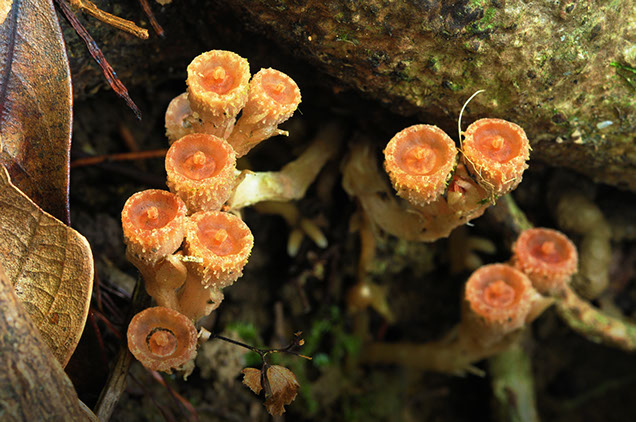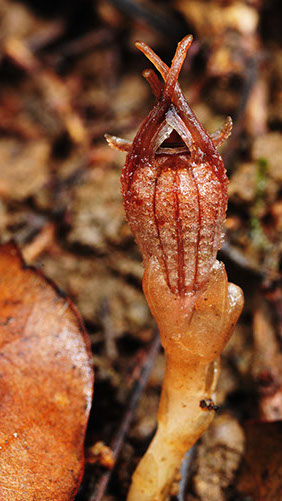
Fruits of Thismia hongkongensis. The lowermost fruit is nearing maturity, with the top beginning to disintegrate to reveal the seeds inside.
(Courtesy of Mar Shek-shing)

Growth Industry
The recent discovery of a new plant species that is endemic to Hong Kong is a reminder that there is more to this city than concrete jungle and that its green areas need to be protected.
Occupying an area of just four square metres in Tai Po Kau Nature Reserve, and growing for much of the year underground, the new plant species – Thismia hongkongensis – could easily have been overlooked. It was noticed by keen amateur biologist Mar Shek-shing from the Society of Hong Kong Nature Explorers and described by the School of Biological Sciences’ Professor Richard Saunders. Thismia hongkongensis is most closely related to a species from Myanmar that was last collected over 170 years ago.
In 22 years at HKU Professor Saunders has described around 70 new species, so such discoveries are not rare. “What sets this new plant apart,” he said, “is, firstly, that it is only known from Hong Kong, raising questions about what else lays undiscovered in our forests; and, secondly, the nature of the plant itself – which is very unusual, and belongs to a genus whose pollination ecology we know little about.
“This brings the whole conservation angle to the fore. There is a lot of debate in political circles at the moment about developing new housing in country parks, but we should be extremely careful before we disrupt any natural environment as we don’t know what we are going to lose.”
His is not a lone voice in the wilderness – public reaction to the discovery has been huge. An Apple Daily article about the new species received 135,000 online hits within days. Professor Saunders is encouraged by people’s interest in Hong Kong’s natural environment.
“At the School of Biological Sciences we have a strong research ethic in ecology and biodiversity, which involves describing species, including new species, and putting them into their evolutionary context in order to reconstruct the evolutionary tree of life and infer how species are related to each other. We’re discovering new things about the local environment – things of global relevance – using local habitats as an experimental location for research of broader significance.”

![]() We’re discovering new things about the local environment – things of global
We’re discovering new things about the local environment – things of global
relevance – using local habitats as an experimental location for research of
broader significance. ![]()
Professor Richard Saunders
Biologically interesting
Thismia hongkongensis is biologically an extremely unusual species and it poses a number of very interesting questions. The plant’s highly reduced anatomy makes it difficult for biologists to understand its broader evolutionary relationships. Professor Saunders’ research students use DNA sequencing data to place organisms in the tree of life and as a basis for developing research hypotheses.
Most plants are autotrophic [able to create their own food] but a small number, including this one, have abandoned that mode of nutrition and obtain food from decaying matter on the forest floor. Plants can’t do that directly so they have a symbiotic relationship with fungi, and the fungi obtain the food from the decaying matter: the plant is able to ‘cultivate’ the fungus as a way of obtaining the food.
“It is a bizarre-looking plant,” said Professor Saunders, “very small, and it doesn’t have green foliage but it does have a highly complex floral anatomy – the flowers are small but elaborate, with tentacles on the top, and an enclosed chamber with pendant stamens.

Flower of Thismia hongkongensis, showing petal lobes with elongated tentacles that cross over the floral aperture.
(Courtesy of Mar Shek-shing)
“There are about 40 species in this genus, but no one knows how it is pollinated,” he continued. “What’s interesting is that when we saw them in the field we didn’t see any insect life around them, but when we dissected them in the laboratory in order to describe the structure, we found a number of dead flies inside. These flies were identified by expert entomologists as belonging to two families of fly – fungus gnats and scuttle flies – tiny flies which are attracted to decaying vegetation. This is the first indication that these might be the pollinators.”
After it has been fertilised, the flower develops into the fruit, which is cup-shaped. At maturity the top of the fruit decays, revealing a cup-like structure with exposed seeds surrounded by a gelatinous coating. There is no empirical evidence about how this structure works, but the speculation is that seeds are dispersed by raindrops which fall into the cups, causing the seeds to splash out.
Finding empirical evidence is the next step for Professor Saunders and his research students. Most of the year the species exists underground, only becoming visible at all when it emerges to flower and fruit, so in the next flowering season they will go back to Tai Po Kau and try to gather more data about pollination and seed dispersal of Thismia hongkongensis.
Back

